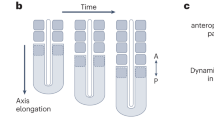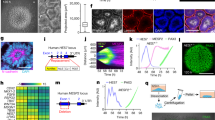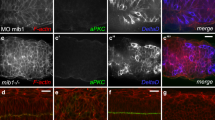Abstract
During vertebrate embryonic development, the paraxial mesoderm is subdivided into metameric subunits called somites. The arrangement and cranio-caudal polarity of the somites governs the metamerism of all somite-derived tissues and spinal ganglia. Little is known about the molecular mechanisms underlying somite formation, segment polarity, maintenance of segment borders, and the interdependency of these processes. The mouse Delta homologue Dll1, a member of the DSL gene family, is expressed in the presomitic mesoderm and posterior halves of somites1. Here we report that, in Dll1-deficient mouse embryos, a primary metameric pattern is established in mesoderm, and cytodifferentiation is apparently normal, but the segments have no cranio-caudal polarity, and no epithelial somites form. Caudal sclerotome halves do not condense, and the pattern of spinal ganglia and nerves is perturbed, indicating loss of segment polarity. Myoblasts span segment borders, demonstrating that these borders are not maintained. These results show that Dll1 is involved in compartmentalization of somites, that dermomyotome and sclerotome differentiation are independent of formation of epithelia and subdivision of somites in cranial and caudal halves, and that compartmentalization is essential for the maintenance of segment borders in paraxial mesoderm-derived structures.
This is a preview of subscription content, access via your institution
Access options
Subscribe to this journal
Receive 51 print issues and online access
$199.00 per year
only $3.90 per issue
Buy this article
- Purchase on Springer Link
- Instant access to full article PDF
Prices may be subject to local taxes which are calculated during checkout
Similar content being viewed by others
References
Bettenhausen, B., Hrabe de Angelis, M., Simon, D., Guenet, J. L. & Gossler, A. Transient and restricted expression during mouse embryogenesis of Dll1, a murine gene closely related to Drosophila Delta Development 21, 2407–2418 (1995).
Campos-Ortega, J. A. Genetic mechanisms of early neurogenesis in Drosophila melanogaster Mol. Neurobiol. 10, 75–89 (1995).
Chitnis, A., Henrique, D., Lewis, J., Ish, Horowicz, D. & Kintner, C. Primary neurogenesis in Xenopus embryos regulated by a homologue of the Drosophila neurogenic gene Delta. Nature 375, 761–766 (1995).
Conlon, R. A., Reaume, A. G. & Rossant, J. Notch1 is required for the coordinate segmentation of somites. Development 121, 1533–1545 (1995).
Keynes, R. J. & Stern, C. D. Mechanisms of vertebrate segmentation. Development 103, 413–429 (1988).
Christ, B., Jacob, M., Jacob, H. J., Brand, B. & Wachtler, F. in Somites in Developing Embryos (eds Bellairs, R., Ede, D. A. & Lash, J. W.) 261–275 (Plenum, New York, 1986).
Stern, C. D. & Keynes, R. J. Interactions between somite cells: the formation and maintenance of segment boundaries in the chick embryo. Development 99, 261–272 (1987).
Keynes, R. J. & Stern, C. D. Segmentation in the vertebrate nervous system. Nature 310, 786–789 (1984).
Stern, C. D., Sisodiya, S. M. & Keynes, R. J. Interactions between neurites and somite cells: inhibition and stimulation of nerve growth in the chick embryo. J. Embryol. Exp. Morphol. 91, 209–226 (1986).
Teillet, M. A., Kalcheim, C. & Le Douarin, N. M. Formation of the dorsal root ganglia in the avian embryo: segmental origin and migratory behavior of neural crest progenitor cells. Dev. Biol. 120, 329–347 (1987).
Davies, J. A., Cook, G. M., Stern, C. D. & Keynes, R. J. Isolation from chick somites of a glycoprotein fraction that causes collapse of dorsal root ganglion growth cones. Neuron 4, 11–20 (1990).
Goldstein, R. S., Teillet, M. A. & Kalcheim, C. The microenvironment created by grafting rostral half-somites is mitogenic for neural crest cells. Proc. Natl. Acad. Sci. USA 87, 4476–4480 (1990).
Burgess, R., Cserjesi, P., Ligon, K. L. & Olson, E. N. Paraxis: a basic helix-loop-helix protein expressed in paraxial mesoderm and developing somites. Dev. Biol. 168, 296–306 (1995).
Montarras, D. et al. Developmental patterns in the expression of Myf5, MyoD, myogenin, and MRF4 during myogenesis. New Biol. 3, 592–600 (1991).
Neubüsler, A., Koseki, H. & Balling, R. Characterization and developmental expression of Pax9, a paired-box-containing gene related to Pax1. Dev. Biol. 170, 701–716 (1995).
Koseki, H. et al. A role for Pax-1 as a mediator of notochordal signals during the dorsoventral specification of vertebrae. Development 119, 649–660 (1993).
Candia, A. F. et al. Mox-1 and Mox-2 define a novel homeobox gene subfamily and are differentially expressed during early mesodermal patterning in mouse embryos. Development 116, 1123–1136 (1992).
Echelard, Y. et al. Sonic hedgehog, a member of a family of putative signaling molecules, is implicated in the regulation of CNS polarity. Cell 75, 1417–1430 (1993).
Hartenstein, A. Y., Rugendorff, A., Tepass, U. & Hartenstein, V. The function of the neurogenic genes during epithelial development in the Drosophila embryo. Development 116, 1203–1220 (1992).
Burgess, R., Rawls, A., Brown, D., Bradley, A. & Olson, E. Requirement of the paraxis gene for somite formation and muscoskeletal patterning. Nature 384, 570–573 (1966).
Meinhardt, H. in Somites in Developing Embryos (eds Bellairs, R., Ede, D. A. & Lash, J. W.) 179–189 (Plenum, New York, 1986).
Sambrook, J., Fritsch, E. F. & Maniatis, T. Molecular Cloning: A Laboratory Manual (Spring Harbor Laboratory Press, NY, 1989).
Nagy, A., Rossant, J., Nagy, R., Abramow Newerly, W. & Roder, J. C. Derivation of completely cell culture-derived mice from early-passage embryonic stem cells. Proc. Natl Acad. Sci. USA 90, 8424–8428 (1993).
Wilkinson, D. G. in In situ hybridization: A practical approach (ed. Wilkinson, D. G.) 75–84 (Oxford Univ. Press, 1992).
Author information
Authors and Affiliations
Rights and permissions
About this article
Cite this article
de Angelis, M., Mclntyre, J. & Gossler, A. Maintenance of somite borders in mice requires the Delta homologue Dll1. Nature 386, 717–721 (1997). https://doi.org/10.1038/386717a0
Received:
Accepted:
Issue Date:
DOI: https://doi.org/10.1038/386717a0
This article is cited by
-
A new fasciocutaneous flap model identifies a critical role for endothelial Notch signaling in wound healing and flap survival
Scientific Reports (2023)
-
Activity of the mouse Notch ligand DLL1 is sensitive to C-terminal tagging in vivo
BMC Research Notes (2021)
-
Comparative and evolutionary analyses reveal conservation and divergence of the notch pathway in lophotrochozoa
Scientific Reports (2021)
-
Role of Notch in endothelial biology
Angiogenesis (2021)
-
The etiology of congenital scoliosis: genetic vs. environmental—a report of three monozygotic twin cases
European Spine Journal (2018)
Comments
By submitting a comment you agree to abide by our Terms and Community Guidelines. If you find something abusive or that does not comply with our terms or guidelines please flag it as inappropriate.



